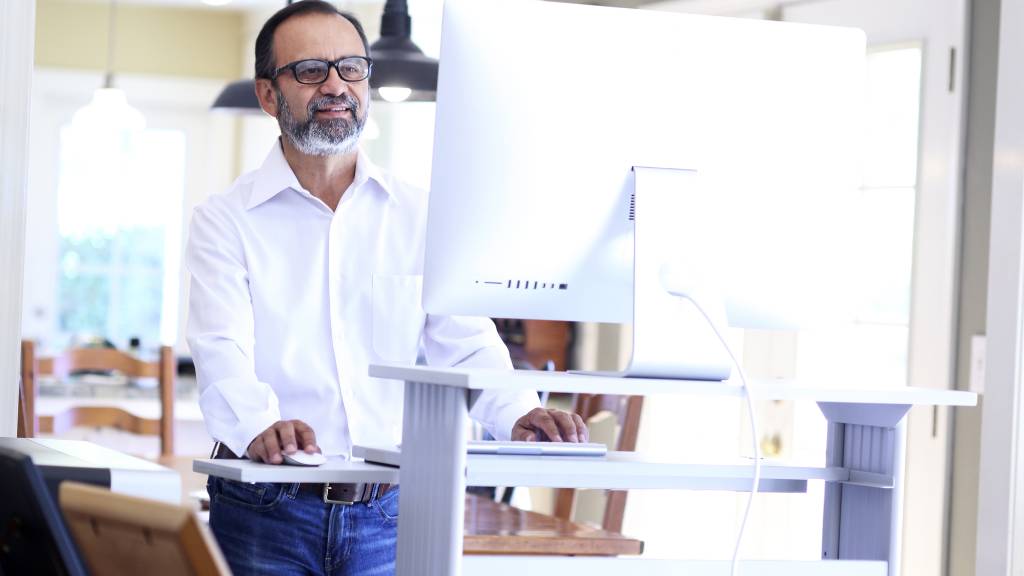What to know about setting up an ergonomic home office

There’s no doubt about it, working from home can be pretty great. No commute, no strict dress code, and minimised noise and distractions that can come from a busy office environment. But seeing as many Australians may be working remotely for the foreseeable future while offices are shut down, it’s important to create a workspace that works for you.
You might have heard the word ‘ergonomic’ thrown around before, but did you know that it’s all about making you safer, more comfortable and more productive? That’s why setting up an ergonomic home office can put you in good stead – both physically and mentally – for however long you’ll be working remotely.
What’s so great about ergonomics?
Don’t just take our word for it that ergonomics in the workplace is beneficial – the stats speak for themselves. Around Australia, businesses spend more than $60 billion every year because of workplace injury and illness, with musculoskeletal disorders making up 60% of serious-injury claims.
Ergonomic products for office workers are designed to reduce musculoskeletal issues, which means you’ll have fewer aches and pains from sitting at your desk and be more productive in your daily activities. Taking a broader view of ergonomics, it even relates to your mental wellbeing, which is very important considering how coronavirus-enforced lockdowns are impacting our stress levels.
Tip #1: Invest in a good-quality ergonomic chair
Search ‘ergonomic chair’ and you’ll get millions of results. There are lots of products on the market, but make sure you do your research and find a chair that hits all the right spots. Most importantly, that means a chair that supports your lower back and doesn’t allow for slouching. Think of it like driving a car – you should be slightly leaning back for the best posture.
If you’d prefer not to spend hundreds of dollars on a special ergonomic chair, you can still take a holistic approach to your set-up. Use a cushion, pillow or rolled-up towel and place it behind your lower back – it’s a cheap solution for effective lumbar support.
Tip #2: Consider a sit–stand desk
Standing desks were all the rage a few years ago, with people touting their health benefits and saying you could get fit while working. The problem in reality, is that standing for long periods of time puts much more strain on your body than sitting. And just like sitting all day is bad for you, standing all day can negatively affect your body.
The solution? Get the best of both worlds with a sit–stand desk. They are easily adjustable and allow you to sit for periods of time when you need to concentrate or are tired and stand for things such as videoconference meetings or if you need to get the blood flowing.
Tip #3: Take care of your hands and wrists
It’s rarely talked about around the water cooler, but wrist and hand problems are the silent issues that can creep up on office workers after years working at a computer. Carpal-tunnel syndrome and repetitive-strain injuries (RSI) are remarkably common among desk-bound workers, and they can lead to painful long-term problems that are expensive and uncomfortable to treat.
You can reduce the chance of this happening to you by investing in ergonomic office devices. From keyboards and computer mouses to ergonomic pens, you’ll be able to protect your hands and wrists from stresses due to repeated use throughout the workday.
Tip #4: Don’t forget about your mental wellbeing
Last but certainly not least, a good ergonomic home office is one that acknowledges the power of mental wellbeing. You don’t have to drop cash on the latest ergonomic product here – just take care of yourself.
That may mean setting up a timer every hour to take a short break from work (e.g. the Pomodoro technique). Just a few minutes spent making a tea or coffee can be good for your brain. Also make it a point to get outside at least once every day. If you’ve got pets, this is a good excuse to take them for a walk.
You might also want to reduce the amount of time you spend on repetitive tasks. If you do lots of typing in your job, for example, a voice-to-text app can make your job easier and maybe even reduce your stress levels. That’s the power of working smarter, not harder.
While you’re spending more time at home, it’s the perfect time to review your life insurance. You might even have more time to get your affairs in order, and it might be time to prioritise what is important to you.
25 Jun 2020